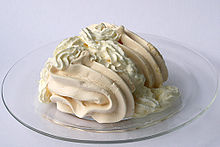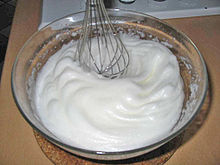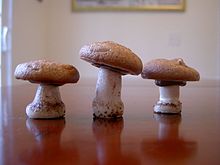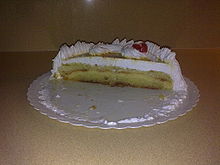- Meringue
-
This article is about the dessert. For the Dominican folk dance and music, see Merengue (dance). For the Haitian folk music, see Méringue.
Meringue
 /məˈræŋ/[1] is a type of dessert made from whipped egg whites and sugar, occasionally some recipes may call for adding an acid such as cream of tartar or a small amount of vinegar and a binding agent such as cornstarch found in icing sugar which may be added in addition to the corn starch which produces a pavlova. Meringues are often flavoured with vanilla and a small amount of almond or coconut extract although if these extracts are based on an oil infusion then this may, if used in excess, may inhibit the egg whites into forming a foam due to the fat from the oil. They are light, airy and sweet while homemade meringues will often be chewy and soft with a crisp exterior and commercial meringues will be crisp throughout.
/məˈræŋ/[1] is a type of dessert made from whipped egg whites and sugar, occasionally some recipes may call for adding an acid such as cream of tartar or a small amount of vinegar and a binding agent such as cornstarch found in icing sugar which may be added in addition to the corn starch which produces a pavlova. Meringues are often flavoured with vanilla and a small amount of almond or coconut extract although if these extracts are based on an oil infusion then this may, if used in excess, may inhibit the egg whites into forming a foam due to the fat from the oil. They are light, airy and sweet while homemade meringues will often be chewy and soft with a crisp exterior and commercial meringues will be crisp throughout.Contents
History
The notion that meringue was invented in the Swiss town of Meiringen[2] by an Italian chef named Gasparini is contested. It is more probable that the name meringue for this confection first appeared in print in François Massialot's cookbook of 1692.[3] The word meringue first appeared in English in 1706 in an English translation of Massialot's book. Two considerably earlier seventeenth-century English manuscript books of recipes give instructions for confections that are recognizable as meringue, though called "white biskit bread" in the book of recipes started in 1604 by Lady Elinor Fettiplace (c. 1570 - c. 1647) of Appleton in Berkshire (now in Oxfordshire),[4] or called "pets" in the manuscript of collected recipes written by Lady Rachel Fane (1612/13 - 1680), of Knole, Kent.[5] Slowly baked meringues are still referred to as "pets" (meaning farts in French) in the Loire region in France due to their light and fluffy texture.[6]
Meringues were traditionally shaped between two large spoons, as they are generally at home today. Meringue piped through a pastry bag with a gored tip (illustration above) was introduced by Antonin Carême.[7]
Type of meringue
There are several types of meringue, the sweetened, uncooked beaten egg whites that form the "islands" of Floating Island (also known in French as île flottante), the partly cooked toppings of lemon meringue pie and other meringue-topped desserts, and the classic dry featherweight meringue. Different preparation techniques produce these results.
- French meringue is the method best known to home cooks. Fine white sugar is beaten into egg whites.
- Italian meringue is made with boiling sugar syrup, instead of caster sugar. This leads to a much more stable soft meringue which can be used in various pastries without collapsing. In an Italian meringue, a hot sugar syrup is whipped into softly whipped egg whites till stiff. This type of meringue is safe to use without cooking. It will not deflate for a long while and can be either used on pies and Baked Alaska, or spread on a sheet and baked for meringues.
- Swiss meringue is whisked over a bain-marie to warm the egg whites, and then whisked steadily until it cools. It is then baked.
Chemistry
When egg whites are beaten, some of the hydrogen bonds in the proteins break, causing the proteins to unfold ("denature") and to aggregate non-specifically. This change in structure leads to the stiff consistency required for meringues. The use of a copper bowl, or the addition of cream of tartar is required to additionally denature the proteins to create the firm peaks, otherwise the whites will not be firm. Plastic bowls, wet or greasy bowls will likely result in the meringue mix being prevented from becoming peaky. Wiping the bowl with a wedge of lemon to remove any traces of grease can often help the process.
When beating egg whites, they are classified in three stages according to the peaks they form when the beater is lifted: soft, firm, and stiff peaks.
Sugar substitutes are not useful in meringue. The sugar is necessary to the structure.
Egg whites and sugar are both hygroscopic (water-attracting) chemicals. Consequently, meringue becomes soggy when refrigerated or stored in a high-humidity environment. This quality also explains the problem called "weeping" or "sweating", in which beads of moisture form on all surfaces of the meringue. Sweating is a particular problem for French meringues in which the granulated sugar is inadequately dissolved in the egg whites, and for high-moisture pie fillings.
Uses
Meringues eaten like biscuits are baked at a very low heat for a long time.[8] One name for them is "Forgotten Cookies"[9] as they can be left in a gas oven for long periods of time after the cooking is done. They are not supposed to be "tanned" at all, but they need to be very crisp and dry. They will keep for at least a week if stored in an airtight container.
Meringue can be used as the basis for various other desserts including angel food cake, pavlova, Baked Alaska, Queen of Puddings, Key lime pie, Eton mess and lemon meringue pie. In these cases, the meringue may be cooked at a higher temperature for a shorter amount of time, resulting in a soft meringue with slightly browned peaks on top.
Another dish is "Meringue de Angel", which consists of shortbread biscuits layered with meringue and lemon curd, topped off with drizzled lemon glaze. Variations include raspberries, peaches, mangos, blueberries, blackberries, pineapple, papayas, honeydew, oranges, cantaloupe, or cherries and strawberries.
Meringue may be used for decoration. It can be formed into whimsical shapes, like mushrooms, or piped into a crisp basket that is baked and filled later with cake, fruit, or flowers.
Meringue tart
A meringue tart is a sponge cake covered with meringue.
Nutritional content
Meringue is a fat-free food, because the presence of even small amounts of fat before the meringue is baked causes the beaten egg whites to collapse. The principal nutritional components are high-quality protein from the egg whites and simple carbohydrates from the refined sugar.
Notes
- ^ William R Trumble, Angus Stevenson, ed (2002). "meringue". Shorter Oxford English Dictionary. 1 (fifth ed.). Oxford: Oxford University Press. pp. 1751. ISBN 0198605757.
- ^ The Oxford English Dictionary states that the French word is of unknown origin.
- ^ Massialot, Nouvelle instruction pour les confitures, les liqueurs et les fruits, (Paris, Charles de Sercy), 1692, noted by Muster (ref.).
- ^ John Spurling produced a three-volume, typescript transcription of Lady Fettiplace’s book (Bristol:Stuart Press) 1994, noted by Muster (ref.).
- ^ Cited in Michael Barry, Old English Recipes, (Jarrod) 1995:64f from the manuscript archived at the Centre for Kentish Studies, Maidstone, Kent.
- ^ Cf. Dr Barry Alcock in Caroline Jeremy (ed.), Green & Black's Chocolate Recipes (Kyle Cathie Ltd), 2003:p.101.
- ^ Ian Kelly, Cooking for Kings: the life of Antonin Carême the first celebrity chef, 2003:60, 225.
- ^ http://www.yummy-coffee-and-food.com/holiday-cookies-meringue.html Meringue Cookies
- ^ http://www.bbcgoodfood.com/recipes/4401/forgotten-cookies
www.meringue.be
External links
Categories:- Desserts
- Egg dishes
- Swiss cuisine
- Culinary Heritage of Switzerland
Wikimedia Foundation. 2010.





